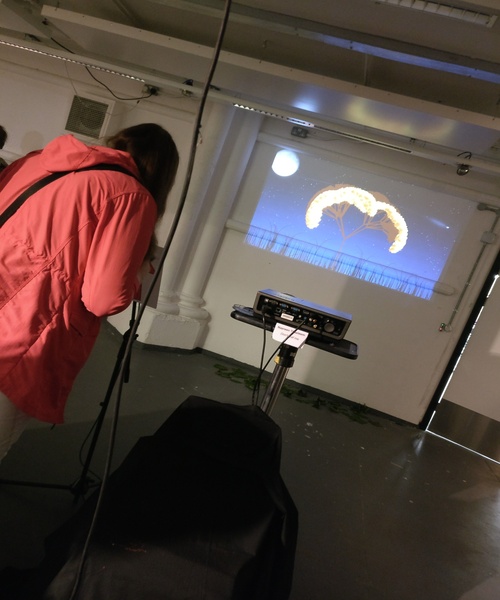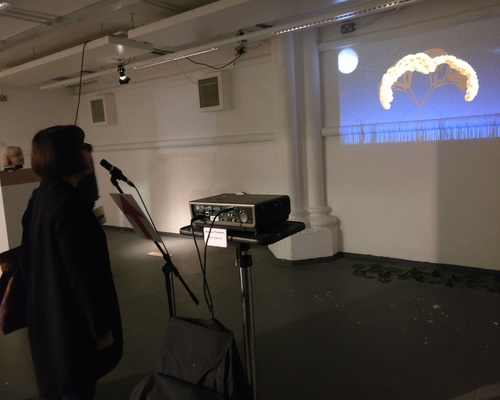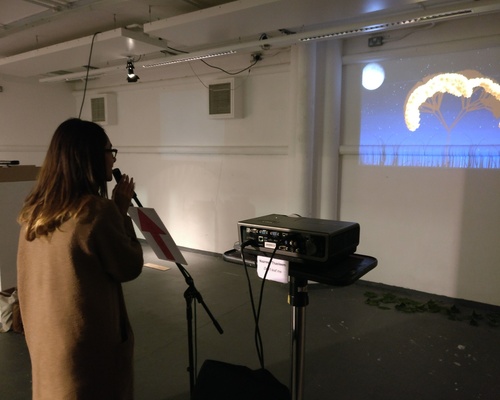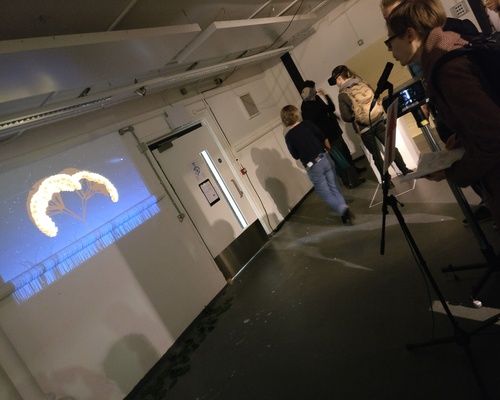Don't leaf me
by: Fathima Nazreen Thasleem
‘Don’t leaf me’ is an interactive installation involving microphone generated graphics. It is essentially a projection on a wall, that elicits an animation when spoken into the microphone .You see the growth of the tree, with branches stretching out towards the top and at the end, if loud enough, coloured leaves appear. When the place gets quiet or if the person steps away from the microphone the leaves slowly disappear. It was displayed against a wall to show the contrast between concrete – something man made and nature. Almost like bringing nature Inside for people to admire.
It was quite a turn from my initial idea of creating a digital art projection exploring optical illusion, our visual perceptions and its limitations conveying process. When researching upon this and looking into immersive art It was quite difficult to come up with a piece to display an interest of optical illusion and I did not want to just project a stationary illusion but rather get the members of public involved with my art.
My main idea of this piece was to ensure the spectators are involved with my work as well as myself. It was also to create something aesthetically pleasing for the viewers, as visually the intention was to grab the viewers sight and make them feel as though they are part of the work, as their voices are detected through the microphone hence generating the animation shown on the screen. The importance of interaction coincides with my previous exhibition work also involving interaction “Paint a picture”. That piece was interesting in terms of being able to view how the audience reacts to the colours displayed on the blank canvas and how ‘painting a picture’ grabs their attention. Similarly, this project had the same intention in terms of grabbing the viewers’ attention except with their voice detected by the microphone.
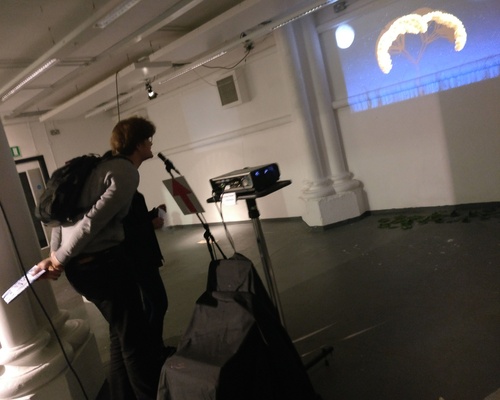

Audience
My projection piece was intended to attract those who are intrigued by projection art or audio visual as it involved audio input and graphics. During the exhibition, I found that people of all ages loved interacting with the piece, from first year students to senior members. They were mainly engrossed by the mass of leaves created if they were to speak aloud. It was also interesting to see how some spectators used it to sing and create some sort of rhythm with their mouths to see if the leaves react in a different way. There were also others who tried to see if the program would crash and thought if they were to scream loudly or put a song on high volume something would happen . Although at that moment it was quiet frustrating, thinking back, this is what interactive art is all about. People love seeing a reaction and are eager to know what would happen if they were to exceed the limit of interaction involved. Although the microphone did have a sign saying, “speak here” people tried experimenting with the interaction, there were people who also started breathing through the microphone or even tapping to create the blossoming of the tree. Considering there was only one microphone put out it was fascinating to see how more than one person for instance a group or couple would come together to speak rather than taking it in turns. It seemed as though, as a group they tended to be more comfortable and so spoke more aloud.
Background research
My background research initially derives from studying interactive installations. I have always been captivated by the concept of getting people involved with your art work rather than them just observing the piece to create an almost intimate experience with the user and yourself and also allows themselves to freely express themselves via interaction. You get a sense of inclusiveness and more engagement from the spectators making it beneficial both to the artists and those experiencing the artistic piece. I also looked into immersive art work and came across the artist Miguel Chevalier. He created “Sur-natures” an interactive installation set using projections against purpose built walls. He used a software called Music2eye, conveying an immersive experience by displaying animation linked to nature. It is a “virtual garden made up with fifteen stringy and luminescent plants which are born randomly, grow up and die according to their morphogenetic code. On the walls, the garden grows up every day in real time and react to passengers.” [1] The interactivity between the viewers and artwork depicts a great impact on how they respond as it conveys aesthetic value with the variety of plants used and shows process as the audience come part of the digital art when they make the animation move depending on where they move. He creates this interactive piece by using motion sensors to “allow visitors to influence the growth of gardens plants. As viewers interact with the artwork, the plants incline to the left or right, creating a scene which alternates between baroque strap work and stylized organic ballet”. He displays “Ultra-Nature, a new digital form of impressionism”. [2] Using nature as his form of projection inspired me to project something to reflect on nature and its beauty. It also has the effect of grabbing the viewers eyes to focus on details or even the process of the animation.
Another Immersive interactive installation I came across was “Encounters(s) 2007 Audio visual Interactive Immersive Installation by Elainie Lillios, Bonnie Mitchell” [3]. These artists also used projectors and sensors to make it an interactive piece. Significantly, Bonnie and Elainie use aesthetic animations combined with audio to almost get a sense of tranquillity and awe. The concept similarly involves the use of nature but in terms of making the viewer think more deeply. It consists of a “10-minute loop of different background animation: 6 different walk and tree morph sequences, 35 narrations, real-time audio and visual effects.” [4] The participant enters “the immersive, abstract sonic and visual environment” and is “enticed to sit in a centrally located, sensor-enhanced chair. After the participant sits down, an abstract human figure emerges”[5]. In this project Bonnie and Elainie create their art to make the spectator become as closely involved as possible although it just comprises just the individual sitting down on a chair, observing the animated figure the user is still made to think without much interaction.
The fact that this piece uses audio as well as really enthused me to create something with audio input instead of what I used for my previous work (the webcam). Nature is always something I’ve admired as well so the amalgamation of both concepts triggered my exhibition piece. To understand audio input further I looked into “ofSoundStream” on the Openframeworks website and used the example to help implement into my code and “get live input from a microphone” [6]
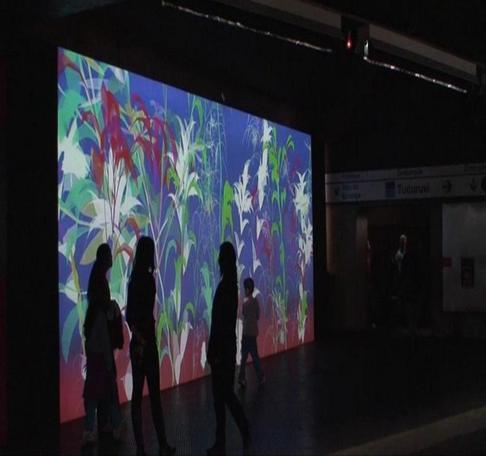

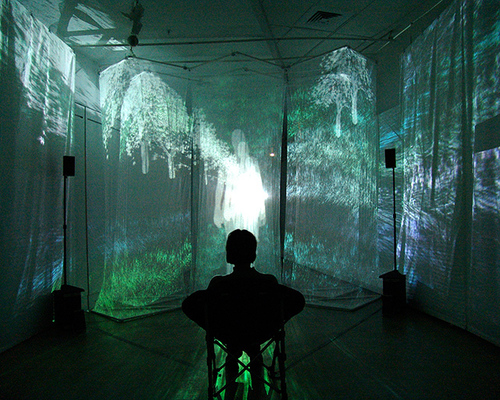

Creative process + Build
At the beginning of this project after my background research I wanted to create something to do with illusions however because of my change of idea it led to me thinking of another concept that still involves interaction but with the use of audio input and graphics. As nature was my main concept I would look into nature based graphics such as fractal trees and recursive trees. The growth of something blossoming was an interest of mine as it represents the fragility and beauty of life, it’s a reminder that life is almost overwhelmingly beautiful but that it is also tragically short. When drawing the tree I followed the steps of first attempting to draw the trunk at the middle of the screen then allowing the trunk to split to draw more branches and at the end of each branch repeating until a sufficient amount is reached.[7] I chose to draw the tree on top of a night sky background as I wanted to create a calm environment for the audience to experience. When we think of a silent night it soothes our perception on everything thus why the tree growth is displayed like that. There is also the moon that flickers to portray feelings of sentiment. The leaves that are shown are bright yellow in order for it to stand out amongst the dark. Furthermore, I chose to display the projection against the wall to contrast between man made and nature. It almost gives the effect of how nature is brought inside. I chose to use audio input with the microphone in terms of interaction so that it would differ from my previous piece which involved the webcam. It was essential to see people interact with my piece to provide a way of understanding how the piece is performed.
During the build of the project It was initially difficult for me to actually start the tree to grow. My initial code was switching between branches and growing a short amount making it look more like a little sprout than a tree. Although the branches were growing according to angle there was no sort of expansion to see the growth of the branches gradually rise instead the random branches would go up and down. To solve this, I ended up starting my code again from scratch with the help of my research on fractal trees and recursive trees there was another way of displaying the growth. By pushing back the branches and adding in a random branch with the use of a timer helped the branches grow accordingly. At the end of the small branches I added in leaves to grow. After completing the growth of the tree it was time to add audio input. This was quiet difficult at first as it did not react responsively as I’d liked it to and crashed if you were to speak to loudly. To solve this, I decreased the value multiplied by the scaled volume to prevent the leaves from disrupting the audio.
Evaluation
Although I did not get to produce my initial idea of projection an illusion piece I am fairly happy with how my final piece turned out. Observing the piece come to life was quite the experience. I received a lot of positive feedback from a range of people, with their own perspective on the interactive installation. Many were curious to what I had used for the audio input and was interested to discuss how it uses your voice to make the tree grow. The mature viewers were mostly fascinated by how the leaves formed at the end of the branches and would tend to use the microphone to sing in pairs and make use of the microphone to their entertainment. They said how it was lovely seeing a piece with something visual as a growth of a tree as it made them feel at ease and almost satisfying. There were also the younger students/spectators who would approach the microphone and try scream through the microphone to see what effect the tree had. It was also interesting to see people who although seeing that the microphone was next to the projection they were timid to try it out, at this point I would have to step in and encourage them to use the microphone to reassure its okay. My colleagues also enjoyed participating with the piece as they loved how the concept was playful in terms of using your voice and allowed them to experiment with the volume of their speech to see the effects of the animation.
For further improvement I would have liked the branches to expand more so that you could see the flow of the branches grow against the wall, I would also ensure to set a threshold for the leaves so that at only a certain point of volume the leaves would appear and if it was to exceed a certain volume perhaps make different coloured leaves appear for instance at first when you speak green leaves would appear but if you were to scream or shout red leaves would appear. In addition, when the microphone is left isolated and the room is quiet I would perhaps allow the leaves to fall to the ground instead of them disappearing. Although it may be a minor issue I would also ensure that the branches to look a bit more thicker especially the tree trunk to give it more of a realistic resemblance, with my current code by using “OfSetLineWidth” I discovered that there was a max amount it would grow as thick, so next time I would try and implement an alternative to solve this. Considering the fact that some parents bring along their children, I would ensure next time that the microphone I use would be more easily adjustable so that they can reach more easily instead of them getting picked up.Furthermore, I think instead of projecting it in an open space where the microphone would bound to pick up surrounding sound I would project it in a closed space room with the room blacked out or the lights switched off in order to create more of an intimate ambiance as well, so that the microphone only picks up the persons speech when close.
References
[1] Sur-natures | interactive installation (2012) Available at: http://www.digitalarti.com/productions/sur-natures-interactive-installation/ (Accessed: 10 May 2017).
[2] Miguel Chevalier (2016) Sur-natures. Available at: http://www.miguel-chevalier.com/en/sur-natures (Accessed: 10 May 2017).
[3] Immersive installation art (2005) Available at: http://immersiveinstallationart.com/theart.html (Accessed: 10 May 2017).
[4] Bonnie Mitchell’s portfolio (no date) Available at: http://bonnie-mitchell.com/artwork.php (Accessed: 10 May 2017).
[5] Bonnie Mitchell’s portfolio (no date) Available at: http://bonnie-mitchell.com/artwork.php (Accessed: 10 December 2017).
[6] Openframeworks Available at : http://openframeworks.cc/documentation/sound/ofSoundStream/ (Accessed: 14 April 2017)
[7] Rosetta code Available at: https://www.rosettacode.org/wiki/Fractal_tree (Accessed: 2 April May 2017)
Link to Repository : Don't leaf me













































































